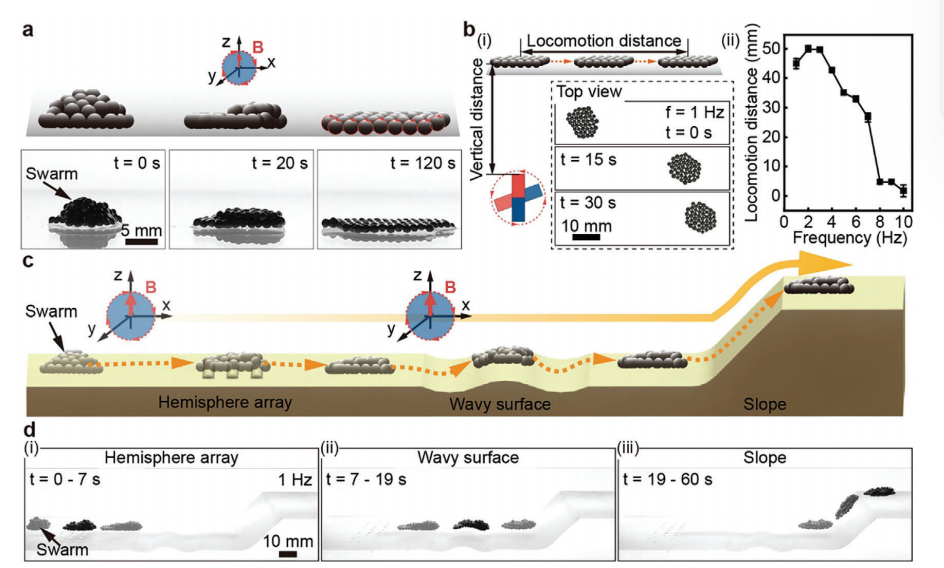

Recently, researchers from Shanghai University and The Chinese University of Hong Kong (Shenzhen) collaborated to develop a novel type of magneto-thermal hydrogel swarms.
Through magnetic-thermal cooperative regulation, the hydrogel swarms can remotely heat magnetic particles using a magnetic field; when magnetic heating is required, they switch to a high-frequency oscillating magnetic field, causing the material to heat up and transition from solid to liquid.
In the in vivo environment, this technology not only achieves precise targeted delivery but also intelligently identifies diseased areas to accurately fill and seal them, providing a new non-invasive treatment solution for gastrointestinal leakage diseases (such as gastric ulcers, gastrointestinal bleeding, and intestinal leakage). Additionally, this technology shows potential application value in treating diseases of hollow organs such as the bladder and uterus.
This research not only expands the application boundaries of magnetic-responsive materials in the biomedical field but also proposes a “magnetic-thermal dual-mode driving” control strategy that offers new ideas for the development of future minimally invasive surgical instruments and targeted drug delivery systems.

Image: Co-corresponding authors Liu Na (left) and Yu Jiangfan (Source: Liu Na)
Recently, a related paper titled Magneto-Thermal Hydrogel Swarms for Targeted Lesion Sealing was published in Advanced Healthcare Materials [1]. Dr. Chen Ziheng from Shanghai University is the first author, and Professor Liu Na from Shanghai University and Assistant Professor Yu Jiangfan from The Chinese University of Hong Kong (Shenzhen) serve as co-corresponding authors.

Image: Related paper (Source: Advanced Healthcare Materials)
In the medical field, gastrointestinal leakage (such as gastric bleeding, gastric perforation, intestinal leakage, etc.) is a common condition usually caused by ulcers, inflammation, or infection. Current treatment options for such conditions include promoting healing of small holes with acid-suppressing drugs and antibiotics, while larger holes still rely on surgical repair.
However, the human intestine is 5-6 meters long, and some areas are difficult to reach with endoscopy. Therefore, how to precisely repair these holes in “diagnostic blind spots” has become a pressing challenge.
Liu Na’s main research direction is small-scale robotic technology, including micro-robots and micro-scale cell manipulation robots, such as screening cells with specific functions for precise medical interventions and developing micro-robots to enter the body’s natural cavities for disease diagnosis and treatment.

Image: Application diagram of magneto-thermal hydrogel swarms (Source: Advanced Healthcare Materials)
To address this clinical challenge, she and her collaborators innovatively proposed a magnetic-driven robotic swarm solution that integrates thermal conversion effects. Based on magnetic driving capabilities, they can enter the body through capsule packaging and oral administration, and be directed to the lesion area under the influence of a magnetic field. By heating the robotic swarm with an external magnetic field, they can release relevant materials from the gel state, achieving precise repair of the wound and filling the holes in the stomach or intestine.
A series of experiments showed that this new method can achieve targeted treatment or emergency wound repair for gastrointestinal holes, especially in areas deep within the gastrointestinal tract that are difficult to reach with traditional methods.
Compared to existing soft gastroscopes or painless gastroscopes (which require intubation), this method achieves completely non-invasive wound repair through oral capsules or gel balls, and has shown ideal repair effects in pig stomach models.

The breakthrough progress of this technology mainly stems from three innovative designs:
First, the magnetic nanoparticles embedded in the material give it magnetic-responsive properties, enabling non-invasive precise navigation while ensuring patient comfort and tolerance.
Second, the unique phase transition characteristics facilitate delivery and help the wound adhere; at 60°C, the swarm can transition from solid to liquid within one minute, and when the temperature drops to 38°C, the swarm transitions from liquid back to solid, a process referred to as “controllable morphological transformation.”
Finally, due to the fluidity of the liquid material, it can better adhere to the wound, and after returning to solid, it can closely fit the wound like a “biological band-aid.”
“The integration of magneto-thermal convertible smart materials with micro-robotic swarms produces significant synergistic effects, achieving an effect of 1+1>2,” Liu Na explained to DeepTech. “We simplified the robot configuration through the principle of magnetic-thermal coupling, using low-frequency rotating magnetic fields to navigate the robots to the target, then switching to high-frequency alternating magnetic fields to trigger material phase transitions and drug release.”
This combination not only provides new ideas for the design of traditional micro-robots but also opens up new fields for the application of smart materials.

Image: Group drug release induced by alternating magnetic fields (Source: Advanced Healthcare Materials)
It is noteworthy that during the process of filling gastrointestinal holes, the material transitions from solid to liquid, which is also the process of precise drug release.
Compared to traditional oral drug delivery (such as drugs for treating chronic enteritis that require enteric coating to resist gastric acid), this “target-triggered” drug release mechanism can effectively avoid drug loss during transit through the digestive tract and significantly increase the drug concentration at the lesion site.
In this study, the researchers have experimentally verified this on animal models, and they are currently collaborating with relevant hospitals to conduct preclinical experimental research and explore clinical translation of related applications.
Based on this research, the team is currently focused on solving the key issue of precise temperature control over long distances, which will help improve the safety and precision of surgeries and is expected to reduce patient suffering and recovery time.
“Once precise temperature control is achieved, the application scenarios of this technology will be greatly expanded, such as enabling remote polyp removal and possibly even thermal treatment of purulent wounds,” Liu Na stated.

References:
1.Chen,Z. et al. Magneto-Thermal Hydrogel Swarms for Targeted Lesion Sealing. Advanced Healthcare Materials (2024). https://doi.org/10.1002/adhm.202403076
Operation/Formatting: He Chenlong, Liu Yakun


 01/ Scientists Successfully Prepare 50cm² Monolayer Graphene Membrane, Breaking Existing Limits of Graphene Gas Separation Membrane Materials, Providing Cost-Effective Solutions for Carbon Capture02/ Academician Gu Min’s Team Develops Optical AI Chip, Enhancing Fiber Transmission Capacity by 10,000 Times, Expected to Be Used in Medical Endoscopic Imaging and Optical Communication03/ The 5,000-Year-Old “Rose Mystery” Finally Revealed: Tsinghua Scholars Uncover the Geometric Secrets of Rose Morphology, Inspiring Smart Materials04/ Parting Ways with Transformers? Sakana AI Proposes “Continuous Thinking Machine” Architecture, Expected to Bridge the Gap Between Artificial Neural Networks and Biological Neural Networks05/ Complexity Reduced from Exponential to Linear, Scientists Create MetaQ Method for Meta-Cell Inference, Making Analysis of Millions of Sequencing Data Possible
01/ Scientists Successfully Prepare 50cm² Monolayer Graphene Membrane, Breaking Existing Limits of Graphene Gas Separation Membrane Materials, Providing Cost-Effective Solutions for Carbon Capture02/ Academician Gu Min’s Team Develops Optical AI Chip, Enhancing Fiber Transmission Capacity by 10,000 Times, Expected to Be Used in Medical Endoscopic Imaging and Optical Communication03/ The 5,000-Year-Old “Rose Mystery” Finally Revealed: Tsinghua Scholars Uncover the Geometric Secrets of Rose Morphology, Inspiring Smart Materials04/ Parting Ways with Transformers? Sakana AI Proposes “Continuous Thinking Machine” Architecture, Expected to Bridge the Gap Between Artificial Neural Networks and Biological Neural Networks05/ Complexity Reduced from Exponential to Linear, Scientists Create MetaQ Method for Meta-Cell Inference, Making Analysis of Millions of Sequencing Data Possible